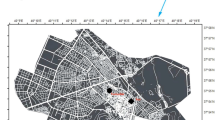Abstract
In Turkey, four degree-day regions stated in the standards are used in building heating energy load calculations. Deficiencies about the degree-day regions are mentioned in some other studies. In this paper, a different climatic zone approach suggested by International Energy Agency (IEA) regarding both heating and cooling degree-day data, derived from Typical Meteorological Year (TMY) data, is used. Results are presented graphically and compared with the current regulations. The second degree-day region, according to Turkish Standard (Thermal Insulation Requirements for Buildings (TS 825)), is divided into four climatic zones with the method proposed by IEA. Difference between monthly outdoor temperature values of the second degree-day region and cities in this region is up to 6.4 °C which is high. The conclusion of this study is that the climatic variables should be evaluated in detail, and a new climatic zone study should be done regarding both heating and cooling loads. This will imply new building energy load calculations for all cities in Turkey.





Similar content being viewed by others
References
Abdulsalam, E., & Mehdi, M. (2010). A method for generation of typical meteorological year. Energy Conversion and Management, 51, 410–417.
Adıgüzel, N., Çomaklı, Ö., Ekmekci, İ., & Pusat, S. (2015). Economical evaluation of a cogeneration system for a building complex. Advances in Mechanical Engineering, 7(3), 1–7.
Aksoy U. T., & Ekici B. B. (2013). TS 825 İklimsel Verilerinin Farkli Derece Gün Bölgeleri İçin Uygunluğunun Değerlendirilmesi. METU JFA (30:2) 163–179, (in Turkish).
ASHRAE. (1989). ASHRAE handbook fundamentals.
Bayram, M., & Yeşilata, B. (2009). Isıtma Ve Soğutma Derece Gün Sayılarının Entegrasyonu. IX. National HVAC and Sanitary Convention and Exhibition, (in Turkish).
BEP - Building Energy Performance Directive. (2008). (in Turkish).
Bolattürk, A. (2008). Optimum insulation thicknesses for building walls with respect to cooling and heating degree-hours in the warmest zone of Turkey. Building and Environment, 43, 1055–1064.
Bulut, H., Büyükalaca, O., & Yılmaz, T. (2007). Türkiye İçin Isıtma Ve Soğutma Derece-Gün Bölgeleri. 16. National Heat Science and Technique Congress, (in Turkish).
Büyükalaca, O., Bulut, H., & Yılmaz, T. (2001). Analysis of variable-base heating and cooling degree-days for Turkey. Applied Energy, 69, 269–283.
Chan, A. L. S., Chow, T. T., Fong, K. F., & Lin, Z. (2006). Generation of a typical meteorological year for Hong Kong. Energy Conversion and Management, 47, 87–96.
Christenson, M., Manz, H., & Gyalistras, D. (2006). Climate warming impact on degree-days and building energy demand in Switzerland. Energy Conversion and Management, 47, 671–686.
EIE. (2006). http://www.eie.gov.tr/projeler/document/TREE_Pres-1_Act_1-5_May06_Building_TS825_Mourtada.pdf. Accessed 03 Jul 2014.
ETKB. www.enerji.gov.tr/index.php?dil=tr&sf=webpages&b=enerjiverimliligi&bn=217&hn=&id=587. Accessed 28 Feb 2012), (in Turkish).
Freeman, T. L. (1979). Evaluation of the “typical meteorological years” for solar heating and cooling system studies. Solar Energy Research Institute, Altas Corporation, Science Applications, Inc.
Harputlugil, G. U. (2009). An assessment model addressed to early phases of Architectural design process prioritised by energy performance. PhD Thesis, Gazi University, Ankara, Turkey.
IEA – International Energy Agency. (2008). Energy efficiency requirements in building codes, energy efficiency policies for new buildings.
Matzarakis, A., & Balafoutis, C. (2004). Heating degree-days over Greece as an index of energy consumption. International Journal of Climatology, 24, 1817–1828.
Oral, G. K., & Akşit, Ş. F. (2001). TS 825 Isı Yalıtım Yönetmeliğinin Konutlarda Isı Korunumu Açısından Değerlendirilmesi. Union of Chambers of Turkish Engineers and Architects, Insulation Congress, Eskişehir, (in Turkish).
Özkan, D. B., & Onan, C. (2011). Optimization of insulation thickness for different glazing areas in buildings for various climatic regions in Turkey. Applied Energy, 88, 1331–1342.
Pusat, S., & Erdem, H. H. (2014). Techno-economic model for district heating systems. Energy and Buildings, 72, 177–185.
Pusat, S., Ekmekçi, İ., & Akkoyunlu, M. T. (2015). Generation of typical meteorological year for different climates of Turkey. Renewable Energy, 75, 144–151.
Santin, O. G., & Itard, L. (2012). The effect of energy performance regulations on energy consumption. Energy Efficiency, 5, 269–282.
Sarak, H., & Satman, A. (2003). The degree-days method to estimate the residential heating natural gas consumption in Turkey: a case study. Energy, 28, 929–939.
Skeiker, K., & Ghani, B. A. (2008). Advanced software tool for the creation of a typical meteorological year. Energy Conversion and Management, 49(10), 2581–2587.
Skeiker, K., & Ghani, B. A. (2009). A software tool for the creation of a typical meteorological year. Renewable Energy, 34(3), 544–554.
Soysal, H. (2001). Turkey’s energy yearbook. Istanbul: Uzman Publishing Inc.
TS 825 – Thermal Insulation Requirements for Buildings. (2008). (in Turkish).
Wierzba, A. L., Morgenstern, M. A., Meyer, S. A., Ruggles, T. H., & Himmelreich, J. (2011). A study to optimize the potential impact of residential building energy audits. Energy Efficiency, 4, 587–597.
Yilmaz, A. Z. (2007). Evaluation of energy efficient design strategies for different climatic zones: comparison of thermal performance of buildings in temperate-humid and hot-dry climate. Energy and Buildings, 39, 306–316.
Yilmaz, A. Z. (2008). Low energy design strategies for different climates of Turkey: comparison of traditional and modern samples. 25th Conference on Passive and Low Energy Architecture, Dublin.
Acknowledgments
Some parts of this study were presented in IX. International HVAC+R Technology Symposium (2010).
Author information
Authors and Affiliations
Corresponding author
Rights and permissions
About this article
Cite this article
Pusat, S., Ekmekci, I. A study on degree-day regions of Turkey. Energy Efficiency 9, 525–532 (2016). https://doi.org/10.1007/s12053-015-9378-7
Received:
Accepted:
Published:
Issue Date:
DOI: https://doi.org/10.1007/s12053-015-9378-7




